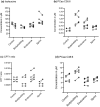Physiological extremes of the human blood metabolome: A metabolomics analysis of highly glycolytic, oxidative, and anabolic athletes
- PMID: 34152092
- PMCID: PMC8215680
- DOI: 10.14814/phy2.14885
Physiological extremes of the human blood metabolome: A metabolomics analysis of highly glycolytic, oxidative, and anabolic athletes
Abstract
Human metabolism is highly variable. At one end of the spectrum, defects of enzymes, transporters, and metabolic regulation result in metabolic diseases such as diabetes mellitus or inborn errors of metabolism. At the other end of the spectrum, favorable genetics and years of training combine to result in physiologically extreme forms of metabolism in athletes. Here, we investigated how the highly glycolytic metabolism of sprinters, highly oxidative metabolism of endurance athletes, and highly anabolic metabolism of natural bodybuilders affect their serum metabolome at rest and after a bout of exercise to exhaustion. We used targeted mass spectrometry-based metabolomics to measure the serum concentrations of 151 metabolites and 43 metabolite ratios or sums in 15 competitive male athletes (6 endurance athletes, 5 sprinters, and 4 natural bodybuilders) and 4 untrained control subjects at fasted rest and 5 minutes after a maximum graded bicycle test to exhaustion. The analysis of all 194 metabolite concentrations, ratios and sums revealed that natural bodybuilders and endurance athletes had overall different metabolite profiles, whereas sprinters and untrained controls were more similar. Specifically, natural bodybuilders had 1.5 to 1.8-fold higher concentrations of specific phosphatidylcholines and lower levels of branched chain amino acids than all other subjects. Endurance athletes had 1.4-fold higher levels of a metabolite ratio showing the activity of carnitine-palmitoyl-transferase I and 1.4-fold lower levels of various alkyl-acyl-phosphatidylcholines. When we compared the effect of exercise between groups, endurance athletes showed 1.3-fold higher increases of hexose and of tetradecenoylcarnitine (C14:1). In summary, physiologically extreme metabolic capacities of endurance athletes and natural bodybuilders are associated with unique blood metabolite concentrations, ratios, and sums at rest and after exercise. Our results suggest that long-term specific training, along with genetics and other athlete-specific factors systematically change metabolite concentrations at rest and after exercise.
Keywords: athlete; energy metabolism; exercise biomarker; exercise phenotype.
© 2021 The Authors. Physiological Reports published by Wiley Periodicals LLC on behalf of The Physiological Society and the American Physiological Society.
Conflict of interest statement
The authors declare that they have no competing financial or non‐financial interests.
Figures





References
-
- Aebersold, R. , & Mann, M. (2016). Mass‐spectrometric exploration of proteome structure and function. Nature, 537, 347–355. - PubMed
-
- Afshin, A. , Forouzanfar, M. H. , Reitsma, M. B. , Sur, P. , Estep, K. , Lee, A. , Marczak, L. , Mokdad, A. H. , Moradi‐Lakeh, M. , Naghavi, M. , Salama, J. S. , Vos, T. , Abate, K. H. , Abbafati, C. , Ahmed, M. B. , Al‐Aly, Z. , Alkerwi, A. , Al‐Raddadi, R. , Amare, A. T. , … Patton, G. C. (2017). Health effects of overweight and obesity in 195 countries over 25 Years. New England Journal of Medicine, 377, 13–27. - PMC - PubMed
-
- Al‐Khelaifi, F. , Donati, F. , Botrè, F. , Latiff, A. , Abraham, D. , Hingorani, A. , Georgakopoulos, C. , Suhre, K. , Yousri, N. A. , & Elrayess, M. A. (2019). Metabolic profiling of elite athletes with different cardiovascular demand. Scandinavian Journal of Medicine and Science in Sports, 29, 933–943. - PubMed
Publication types
MeSH terms
Substances
Grants and funding
LinkOut - more resources
Full Text Sources

